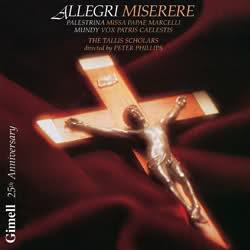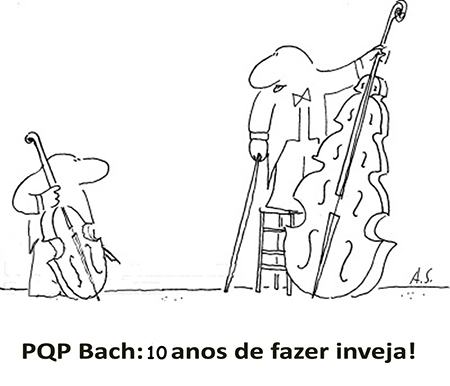 Allegri: Miserere
Allegri: Miserere
Mundy: Vox Patris caelestis
Palestrina: Missa Papae Marcelli
The Tallis Scholars)
Escolhida pela “BBC Music Magazine” como uma das 50 melhores gravações de todos os tempos e amplamente considerada como a melhor gravação do Miserere Allegri, esta memorável gravação foi realizada no Merton College Chapel, Oxford, em 1980, e estabeleceu novas normas para o desempenho e gravação de música sacra desacompanhada e provou ser um sucesso imediato artístico e comercial, atingindo o primeiro lugar no UK HMV Classical Chart em fevereiro de 1981. Esta edição é comemorativa do 25º aniversário dessa gravação.
Gregorio Allegri escreveu o Miserere pouco antes de 1638 para a celebração anual das matinas durante a Semana Santa (a celebração da Páscoa). Duas vezes durante essa semana, na quarta-feira e sexta-feira, o serviço teria início às 03:00, quando seriam extintas 27 velas, uma de cada vez, até que apenas uma permanecesse acesa. Segundo relatos, o Papa participaria desses serviços. Allegri compôs o Miserere para o final dos serviços “Tenebrae” (Tenebrae refere-se à extinção gradual das velas, uma por uma, durante os últimos três dias na Semana Santa, simbolizando a morte de Cristo e os três dias no sepulcro.). Na última vela o Papa se ajoelhava diante do altar e rezava enquanto o Miserere era cantado, culminando o serviço.
Allegri’s Miserere and Palestrina’s Missa Papae Marcelli are widely recognised as being of the finest music to come from the Golden age: they must receive more performances throughout the world than any other pieces of unaccompanied sacred music. We introduce William Mundy’s Vox Patris caelestis in order to establish the reputation of a masterpiece and of an English composer. It happens that Mundy wrote Vox Patris caelestis in almost exactly the same year as Palestrina wrote his Missa Papae Marcelli; by coupling them we can appreciate the extraordinary variety in sacred music which existed at that time between England and the continent.
Allegri’s Miserere is quite simple in conception and much of its impact relies on the conditions of performance, especially on the acoustic. The Tallis Scholars have used a reverberant building – Merton College Chapel in Oxford – and placed the solo group at some distance from the remainder of the choir. There are five sections in the music, which are identical except for the second half of the final verse where the solo group and the main choir at last join up, singing from the extreme ends of the chapel. The musical effect is created by Allegri’s use of discords (caused by a series of suspensions) and by embellishments around a straight-forward vocal line, which take the solo treble to a high C. The text is the whole of Psalm 51, perhaps the most penitential of all the psalms, traditionally sung in the Anglican rite on Ash Wednesday and in the Catholic rite during the last three days of Holy Week. (1980, rev. 1990 Peter Phillips)
Palhinha: ouça 01. Miserere
Gregorio Allegri (1582-1652)
01. Miserere
William Mundy (c.1529-1591)
02. Vox Patris caelestis
Giovanni Pierluigi da Palestrina (c.1525-1594)
03. Missa Papae Marcelli – 1. Kyrie
04. Missa Papae Marcelli – 2. Gloria
05. Missa Papae Marcelli – 3. Credo
06. Missa Papae Marcelli – 4. Sanctus & Benedictus
07. Missa Papae Marcelli – 5. Agnus Dei I & II
Allegri – Miserere (25th Anniversary Edition) – 2005
The Tallis Scholars
Peter Phillips, director
BAIXE AQUI – DOWNLOAD HERE
XLD RIP | 283,7 MB | Encarte | 1,1 h
powered by iTunes 12.1.0
BAIXE AQUI – DOWNLOAD HERE
MP3 320 kbps – Encarte – 146,4 MB – 1,1 h
powered by iTunes 12.1.0
Partituras e outros que tais? Clique aqui
Boa audição.
Avicenna
